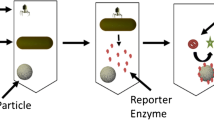A bacteriophage-based biosorbent for Salmonella enteritidis was constructed, and bacterial bioluminescence was used for assessment of the efficiency of cell capture. A strain of S. enteritidis with bioluminescent phenotype was constructed by transformation with plasmid pT7 carrying the entire lux operon from Photorhabdus luminescens. The relation between relative light output (RLU) and colony-forming units (CFU/ml) of the bioluminescent strain was established. The bacteriophage specific to S. enteritidis was biotinylated, and the biotinylation procedure was optimized based on the maximum retention of phage infectivity. The biotinylated phages were then coated onto streptavidin-labeled magnetic beads, and were used to capture the bioluminescent S. enteritidis cells. Our preliminary results showed that the number of cells captured by constructed biosorbent was five times higher than that of the control, magnetic beads coated with nonbiotinylated phage, indicating the capture is specific. Journal of Industrial Microbiology & Biotechnology (2000) 25, 273–275.
Similar content being viewed by others
Author information
Authors and Affiliations
Additional information
Received 06 June 2000/ Accepted in revised form 30 August 2000
Rights and permissions
About this article
Cite this article
Sun, W., Brovko, L. & Griffiths, M. Use of bioluminescent Salmonella for assessing the efficiency of constructed phage-based biosorbent. J Ind Microbiol Biotech 25, 273–275 (2000). https://doi.org/10.1038/sj.jim.7000074
Issue Date:
DOI: https://doi.org/10.1038/sj.jim.7000074




